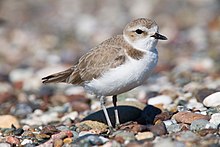The snowy plover (Charadrius nivosus) is a small wader in the plover bird family. It breeds in Ecuador, Peru, Chile, the southern and western United States and the Caribbean. Long considered to be a subspecies of the Kentish plover, it is now known to be a distinct species.
The snowy plover breeds on sandy coasts and brackish inland lakes, and is uncommon on fresh water. It nests in a ground scrape and lays three to five eggs.[3]
Snowy Plover
Snowy Plover at Point Reyes National Seashore, California.
The breeding birds in warmer countries are largely sedentary, but northern and inland populations are migratory, wintering south to the tropics. Food is insects and other invertebrates, which are obtained by a run-and-pause technique, rather than the steady probing of some other wader groups.
The snowy plover breeds from Texas and Oklahoma west to California and up the coastline to Oregon and Washington, with the coastal form’s primary breeding concentration in central and southern California.[4] On March 5, 1993 the western snowy plover was listed as a threatened species under the Endangered Species Act of 1973. As of June 19, 2012, the habitat along the California, Oregon, and Washington Coasts have been listed as critical.[5]
In many parts of the world, it has become difficult for this species to breed on beaches because of disturbance from the activities of humans or their animals. The University of California, Santa Barbara (UCSB) is currently endeavoring to rehabilitate snowy plover populations by protecting beaches along the central California coastline that runs along part of the university campus.[6] UCSB has had some success in encouraging reproduction; the university also often trains students and other volunteers to watch over protected beaches during the daytime to ensure no one disturbs nesting grounds.
The beaches lining Vandenberg Air Force Base in Central California are also home to several protected areas where breeding has been successful in recent years. Access to these beaches is limited to certain times of the year, and very specific areas are open to keep the bird protected. Most of these beaches are only open to military personnel and their families.

